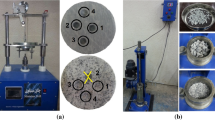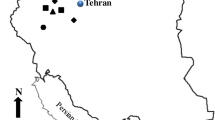Abstract
The purpose of this paper is to provide a proper, practical and convenient drilling rate index (DRI) prediction model based on rock material properties. In order to obtain this purpose, 47 DRI tests were used. In addition, the relevant strength properties i.e. uniaxial compressive strength and Brazilian tensile strength were also used and selected as input parameters to predict DRI. Examined simple regression analysis showed that the relationships between the DRI and predictors are statistically meaningful but not good enough for DRI estimation in practice. Moreover, multiple regression, artificial neural network (ANN) and hybrid genetic algorithm (GA)-ANN models were constructed to estimate DRI. Several performance indices i.e. coefficient of determination (R2), root mean square error and variance account for were used for evaluation of performance prediction the proposed methods. Based on these results and the use of simple ranking procedure, the best models were chosen. It was found that the hybrid GA-ANN technique can performed better in predicting DRI compared to other developed models. This is because of the fact that the proposed hybrid model can update the biases and weights of the network connection to train by ANN.












Similar content being viewed by others
References
Adebayo B, Opafunso ZO, Akande JM (2010) Drillability and strength characteristics of selected rocks in Nigeria. AU J Technol 14(1):56–60
Aghajanloo MB, Sabziparvar AA, Talaee PH (2013) Artificial neural network–genetic algorithm for estimation of crop evapotranspiration in a semi-arid region of Iran. Neural Comput Appl 23(5):1387–1393
Akin S, Karpuz C (2008) Estimating drilling parameters for diamond bit drilling operations using artificial neural networks. Int J Geomech 8(1):68–73
Arabjamaloei R, Karimi Dehkordi B (2012) Investigation of the most efficient approach of the prediction of the rate of penetration. Energy Sour A Recov Util Environ Eff 34(7):581–590
Armaghani DJ, Momeni E, Alavi Nezhad Khalil Abad SV, Khandelwal M (2015a) Feasibility of ANFIS model for prediction of ground vibrations resulting from quarry blasting. DOI, Environ Earth Sci. doi:10.1007/s12665-015-4305-y
Armaghani DJ, Tonnizam Mohamad E, Hajihassani M, Alavi Nezhad Khalil Abad SV, Marto A, Moghaddam MR (2015b) Evaluation and prediction of flyrock resulting from blasting operations using empirical and computational methods. Eng Comput. doi:10.1007/s00366-015-0402-5
Armaghani DJ, Hajihassani M, Sohaei H, Mohamad ET, Marto A, Motaghedi H, Moghaddam MR (2015c) Neuro-fuzzy technique to predict air-overpressure induced by blasting. Arab J Geosci 1–14
Ataei M, KaKaie R, Ghavidel M, Saeidi O (2015) Drilling rate prediction of an open pit mine using the rock mass drillability index. Int J Rock Mech Min Sci 73:130–138
Basarir H, Tutluoglu L, Karpuz C (2014) Penetration rate prediction for diamond bit drilling by adaptive neuro-fuzzy inference system and multiple regressions. Eng Geol 173:1–9
Bruland A (1998) Drillability test methods. NTNU, Trondheim
Caudill M (1988) Neural networks primer part III. Al Expert 3:53–59
Chambers LD (2010) Practical handbook of genetic algorithms: complex coding systems. CRC Press, Boca Raton
Cheniany A, Hasan KS, Shahriar K, Hamidi JK (2012) An estimation of the penetration rate of rotary drills using the Specific Rock Mass Drillability index. Int J Rock Mech Min Sci 22:187–193
Chipperfield A, Fleming P, Pohlheim H (2006) Genetic algorithm toolbox for use with MATLAB user’s guide. version 1.2. University of Sheffield
Dahl F (2003) DRI, BWI, CLI standards. NTNU, Angleggsdrift, Trondheim
Dahl F, Bruland A, Jakobsen PD, Nilsen B, Grøv E (2012) Classifications of properties influencing the drillability of rocks, based on the NTNU/SINTEF test method. Tunnel Undergr Sp Technol 28:150–158
Dreyfus G (2005) Neural networks: methodology and application. Springer, Berlin
Ekincioglu G, Altindag R, Sengun N, Demirdag S, Guney A (2013) The relationships between drilling rate index (DRI), physico-mechanical properties and specific cutting energy for some carbonate rocks, rock mechanics for resources, energy and environment. Taylor & Francis, London, pp 867–873
Garrett J (1994) Where and why artificial neural networks are applicable in civil engineering. J Comput Civil Eng 8:129–130
Hagan MT, Menhaj MB (1994) Training feed forward networks with the Marquardt algorithm. IEEE Trans Neural Networks 5:861–867
Hajihassani M, Armaghani DJ, Marto A, Tonnizam Mohamad E (2014) Ground vibration prediction in quarry blasting through an artificial neural network optimized by imperialist competitive algorithm. Bull Eng Geol Environ. doi:10.1007/s10064-014-0657-x
Hecht-Nielsen R (1987) Kolmogorov’s mapping neural network existence theorem. In: Proceedings of the first IEEE international conference on neural networks, San Diego, CA, pp 11–14
Holland J (1975) Adaptation in natural and artificial systems. The University of Michigan Press, Ann Arbor
Hornik K, Stinchcombe M, White H (1989) Multilayer feedforward networks are universal approximators. Neural Netw 2:359–366
Hoseinie SH, Aghababaei H, Pourrahimian Y (2008) Development of a new classification system for assessing of rock mass drillability index (RDi). Int J Rock Mech Min Sci 45:1–10
Hoseinie SH, Ataei M, Osanloo M (2009) A new classification system for evaluating rock penetrability. Int J Rock Mech Min Sci 46:1329–1340
Hush DR (1989) Classification with neural networks: a performance analysis. In: Proceedings of the IEEE international conference on systems engineering. Dayton, OH, pp 277–280
SPSS Inc (2007). SPSS for Windows (Version 16.0). SPSS Inc, Chicago
ISRM (1978) Suggested methods for determining tensile strength of rock materials. Int J Rock Mech Min Sci Geomech Abstr 15:101–103
ISRM (1979) Suggested methods for determining the uniaxial compressive strength and deformability of rock materials. Int J Rock Mech Min Sci Geomech Abstr 16:135–140
Jaeger JC (1967) Failure of rocks under tensile strength. Int J Rock Mech Min Sci 4:219–227
Kaastra I, Boyd M (1996) Designing a neural network for forecasting financial and economic time series. Neurocomputing 10:215–236
Kahraman S (1999) Rotary and percussive drilling prediction using regression analysis. Int J Rock Mech Min Sci 36:981–989
Kahraman S, Balcı C, Yazıcı S, Bilgin N (2000) Prediction of the penetration rate of rotary blast hole drills using a new drillability index. Int J Rock Mech Min Sci 37:729–743
Kahraman S, Bilgin N, Feridunoglu C (2003) Dominant rock properties affecting the penetration rate of percussive drills. Int J Rock Mech Min Sci 40:711–723
Kanellopoulas I, Wilkinson GG (1997) Strategies and best practice for neural network image classification. Int J Remote Sens 18:711–725
Karpuz C, Pasamehmetoglu AG, Dincer T, Muftuoglu Y (1990) Drillability studies on the rotary blast hole drilling of lignite overburden series. Int J Surf Min Recl 4:89–93
Khandelwal M (2013) Correlating P-wave velocity with the physico-mechanical properties of different rocks. Pure appl Geophys 170(4):507–514
Khandelwal M, Monjezi M (2013) Prediction of backbreak in open-pit blasting operations using the machine learning method. Rock Mech Rock Eng 46(2):389–396
Khandelwal M, Ranjith PG (2010) Correlating index properties of rocks with P-wave measurements. J Appl Geophys 71(1):1–5
Lee Y, Oh SH, Kim MW (1991) The effect of initial weights on premature saturation in back-propagation learning, In: Proceedings of the international joint conference on neural networks, pp 765–770
Macias FJ, Jakobsen PD, Seo Y, Bruland A (2014) Influence of rock mass fracturing on the net penetration rates of hard rock TBMs. Tunnel Undergr Sp Technol 44:108–120
Majdi A, Beiki M (2010) Evolving neural network using a genetic algorithm for predicting the deformation modulus of rock masses. Int J Rock Mech Min Sci 47:246–253
Masters T (1994) Practical neural network recipes in C ++. Academic Press, Boston
Moein MJA, Shaabani E, Rezaeian M (2014) Experimental evaluation of hardness models by drillability tests for carbonate rocks. J Petroleum Sci Eng 113:104–108
Momeni E, Nazir R, Armaghani DJ, Maizir H (2014) Prediction of pile bearing capacity using a hybrid genetic algorithm-based ANN. Measurement 57:122–131
Monjezi M, Khoshalan HA, Varjani AY (2012) Prediction of flyrock and backbreak in open pit blasting operation: a neuro-genetic approach. Arab J Geosci 5(3):441–448
Nelson M, Illingworth WT (1990) A practical guide to neural nets. Addison-Wesley, Reading
Paola JD (1994) Neural network classification of multispectral imagery. MSc thesis, The University of Arizona
Rashidian V, Hassanlourad M (2013) Predicting the shear behavior of cemented and uncemented carbonate sands using a genetic algorithm-based artificial neural network. Geotech Geol Eng 2:1–18
Ripley BD (1993) Statistical aspects of neural networks. In: Barndoff- Neilsen OE, Jensen JL, Kendall WS, editors. Networks and chaos-statistical and probabilistic aspects. London: Chapman & Hall, pp 40-123
Saemi M, Ahmadi M, Varjani AY (2007) Design of neural networks using genetic algorithm for the permeability estimation of the reservoir. J Petroleum Sci Eng 59:97–105
Schmidt RL (1972) Drillability Studies – Percussive Drilling in the Field, US Bureau of Mines RI 7684
Selim AA, Bruce WE (1970) Prediction of penetration rate for percussive drilling. USBM. RI; p 7396
Selmer-Olsen R, Lien R (1960) Bergartens borbarhet og sprengbarhet, Teknisk Ukeblad, 34, Oslo, pp 3–11
Sievers H (1950) Die Bestimmung des Bohrwiderstandes von Gesteinen, Glückauf 86: 37/38, pp 776–784. Glückauf G.M.B.H., Essen
Simpson P (1990) Artificial neural system: foundation, paradigms, applications and implementations. Pergamon, New York
Sonmez H, Gokceoglu C, Nefeslioglu HA, Kayabasi A (2006) Estimation of rock modulus: for intact rocks with an artificial neural network and for rock masses with a new empirical equation. Int J Rock Mech Min Sci 43:224–235
Swingler K (1996) Applying neural networks: a practical guide. Academic Press, New York
Tripathy A, Singh TN, Kundu J (2015) Prediction of abrasiveness index of some Indian rocks using soft computing methods. Measurement 68:302–309
von Matern N, Hjelmer A (1943) Försök med pågrus (‘Tests with chippings), Medelande nr. 65, Statens väginstitut, Stockholm, 65 pp (English summary, pp 56–60)
Wang C (1994) A theory of generalization in learning machines with neural application. PhD thesis, The University of Pennsylvania
Wijk G (1989) The stamp test for rock drillability classification. Int J Rock Mech Min Sci Geomech Abstr 26:37–44
Yagiz S, Gokceoglu C, Sezer E, Iplikci S (2009) Application of two non-linear prediction tools to the estimation of tunnel boring machine performance. Eng Appl Artif Intel 22(4):808–814
Yang Y, Zang O (1997) A hierarchical analysis for rock engineering using artificial neural networks. Rock Mech Rock Eng 30:207–222
Yarali O, Kahraman S (2011) The drillability assessment of rocks using the different brittleness values. Tunnel Undergr Sp Technol 26:406–414
Yarali O, Soyer E (2013) Assessment of relationships between drilling rate index and mechanical properties of rocks. Tunnel Undergr Sp Technol 33:46–53
Zorlu K, Gokceoglu C, Ocakoglu F, Nefeslioglu HA, Acikalin S (2008) Prediction of uniaxial compressive strength of sandstones using petrography-based models. Eng Geol 96(3):141–158
Author information
Authors and Affiliations
Corresponding author
Rights and permissions
About this article
Cite this article
Khandelwal, M., Armaghani, D.J. Prediction of Drillability of Rocks with Strength Properties Using a Hybrid GA-ANN Technique. Geotech Geol Eng 34, 605–620 (2016). https://doi.org/10.1007/s10706-015-9970-9
Received:
Accepted:
Published:
Issue Date:
DOI: https://doi.org/10.1007/s10706-015-9970-9




